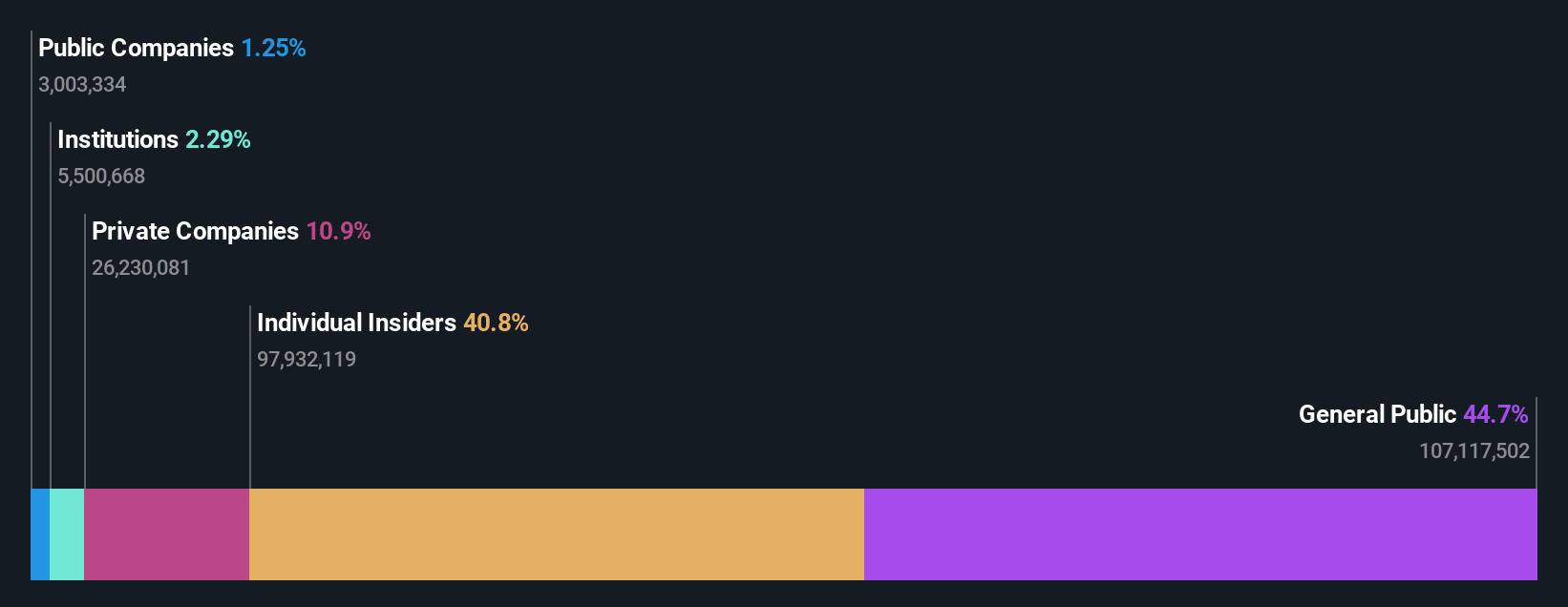Nyrada Inc.'s (ASX:NYR) stock price dropped 10% last week; individual investors would not be happy
Key Insights
- Nyrada's significant individual investors ownership suggests that the key decisions are influenced by shareholders from the larger public
- The top 24 shareholders own 50% of the company
- Insider ownership in Nyrada is 41%
A look at the shareholders of Nyrada Inc. (ASX:NYR) can tell us which group is most powerful. The group holding the most number of shares in the company, around 45% to be precise, is individual investors. Put another way, the group faces the maximum upside potential (or downside risk).
Following a 10% decrease in the stock price last week, individual investors suffered the most losses, but insiders who own 41% stock also took a hit.
Let's delve deeper into each type of owner of Nyrada, beginning with the chart below.
See our latest analysis for Nyrada

What Does The Institutional Ownership Tell Us About Nyrada?
Institutions typically measure themselves against a benchmark when reporting to their own investors, so they often become more enthusiastic about a stock once it's included in a major index. We would expect most companies to have some institutions on the register, especially if they are growing.
Less than 5% of Nyrada is held by institutional investors. This suggests that some funds have the company in their sights, but many have not yet bought shares in it. If the company is growing earnings, that may indicate that it is just beginning to catch the attention of these deep-pocketed investors. When multiple institutional investors want to buy shares, we often see a rising share price. The past revenue trajectory (shown below) can be an indication of future growth, but there are no guarantees.

We note that hedge funds don't have a meaningful investment in Nyrada. Mark Azzi is currently the largest shareholder, with 16% of shares outstanding. Ian Dixon is the second largest shareholder owning 4.3% of common stock, and John Moore holds about 3.0% of the company stock. John Moore, who is the third-largest shareholder, also happens to hold the title of Chairman of the Board. Additionally, the company's CEO James Bonnar directly holds 0.5% of the total shares outstanding.
After doing some more digging, we found that the top 24 have the combined ownership of 50% in the company, suggesting that no single shareholder has significant control over the company.
While it makes sense to study institutional ownership data for a company, it also makes sense to study analyst sentiments to know which way the wind is blowing. Our information suggests that there isn't any analyst coverage of the stock, so it is probably little known.
Insider Ownership Of Nyrada
The definition of an insider can differ slightly between different countries, but members of the board of directors always count. Management ultimately answers to the board. However, it is not uncommon for managers to be executive board members, especially if they are a founder or the CEO.
I generally consider insider ownership to be a good thing. However, on some occasions it makes it more difficult for other shareholders to hold the board accountable for decisions.
It seems insiders own a significant proportion of Nyrada Inc.. It has a market capitalization of just AU$157m, and insiders have AU$64m worth of shares in their own names. This may suggest that the founders still own a lot of shares. You can click here to see if they have been buying or selling.
General Public Ownership
The general public-- including retail investors -- own 45% stake in the company, and hence can't easily be ignored. While this size of ownership may not be enough to sway a policy decision in their favour, they can still make a collective impact on company policies.
Private Company Ownership
We can see that Private Companies own 11%, of the shares on issue. It's hard to draw any conclusions from this fact alone, so its worth looking into who owns those private companies. Sometimes insiders or other related parties have an interest in shares in a public company through a separate private company.
Next Steps:
It's always worth thinking about the different groups who own shares in a company. But to understand Nyrada better, we need to consider many other factors. Case in point: We've spotted 2 warning signs for Nyrada you should be aware of.
If you would prefer check out another company -- one with potentially superior financials -- then do not miss this free list of interesting companies, backed by strong financial data.
NB: Figures in this article are calculated using data from the last twelve months, which refer to the 12-month period ending on the last date of the month the financial statement is dated. This may not be consistent with full year annual report figures.
Valuation is complex, but we're here to simplify it.
Discover if Nyrada might be undervalued or overvalued with our detailed analysis, featuring fair value estimates, potential risks, dividends, insider trades, and its financial condition.
Access Free AnalysisHave feedback on this article? Concerned about the content? Get in touch with us directly. Alternatively, email editorial-team (at) simplywallst.com.
This article by Simply Wall St is general in nature. We provide commentary based on historical data and analyst forecasts only using an unbiased methodology and our articles are not intended to be financial advice. It does not constitute a recommendation to buy or sell any stock, and does not take account of your objectives, or your financial situation. We aim to bring you long-term focused analysis driven by fundamental data. Note that our analysis may not factor in the latest price-sensitive company announcements or qualitative material. Simply Wall St has no position in any stocks mentioned.
About ASX:NYR
Nyrada
A pre-clinical stage drug development company, engages in the development of small molecule drugs for cardiovascular and neurological diseases.
Flawless balance sheet with very low risk.
Market Insights
Community Narratives



